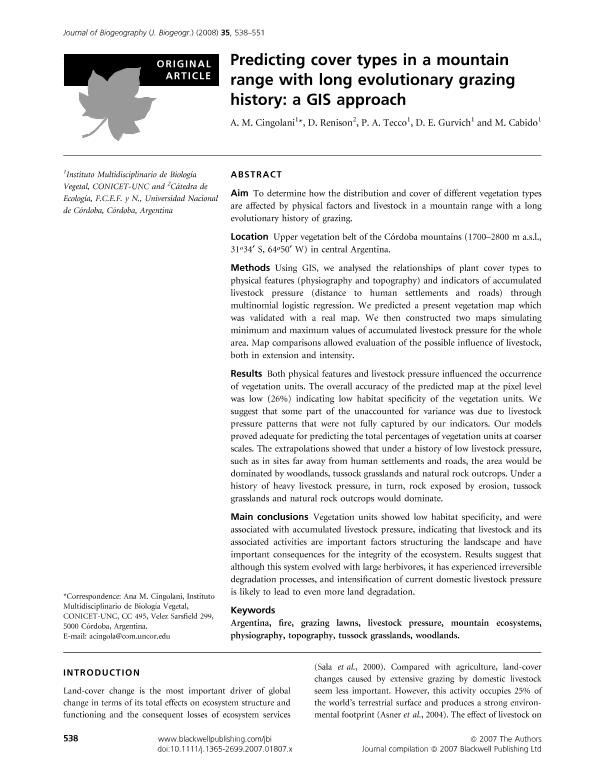Artículo
Predicting cover types in a mountain range with long evolutionary history of grazing: a GIS approach
Cingolani, Ana María ; Renison, Daniel
; Renison, Daniel ; Tecco, Paula Andrea
; Tecco, Paula Andrea ; Gurvich, Diego Ezequiel
; Gurvich, Diego Ezequiel ; Cabido, Marcelo Ruben
; Cabido, Marcelo Ruben
 ; Renison, Daniel
; Renison, Daniel ; Tecco, Paula Andrea
; Tecco, Paula Andrea ; Gurvich, Diego Ezequiel
; Gurvich, Diego Ezequiel ; Cabido, Marcelo Ruben
; Cabido, Marcelo Ruben
Fecha de publicación:
03/2008
Editorial:
Wiley Blackwell Publishing, Inc
Revista:
Journal of Biogeography
ISSN:
0305-0270
e-ISSN:
1365-2699
Idioma:
Inglés
Tipo de recurso:
Artículo publicado
Clasificación temática:
Resumen
Aim To determine how the distribution and cover of different vegetation types are affected by physical factors and livestock in a mountain range with a long evolutionary history of grazing. Location Upper vegetation belt of the Córdoba mountains (1700–2800 m a.s.l., 31º34' S, 64º50' W) in central Argentina. Methods Using GIS, we analysed the relationships of plant cover types to physical features (physiography and topography) and indicators of accumulated livestock pressure (distance to human settlements and roads) through multinomial logistic regression. We predicted a present vegetation map which was validated with a real map. We then constructed two maps simulating minimum and maximum values of accumulated livestock pressure for the whole area. Map comparisons allowed evaluation of the possible influence of livestock,both in extension and intensity. Results Both physical features and livestock pressure influenced the occurrence of vegetation units. The overall accuracy of the predicted map at the pixel level was low (26%) indicating low habitat specificity of the vegetation units. We suggest that some part of the unaccounted for variance was due to livestock pressure patterns that were not fully captured by our indicators. Our models proved adequate for predicting the total percentages of vegetation units at coarser scales. The extrapolations showed that under a history of low livestock pressure, such as in sites far away from human settlements and roads, the area would be dominated by woodlands, tussock grasslands and natural rock outcrops. Under a history of heavy livestock pressure, in turn, rock exposed by erosion, tussock grasslands and natural rock outcrops would dominate. Main conclusions Vegetation units showed low habitat specificity, and were associated with accumulated livestock pressure, indicating that livestock and its associated activities are important factors structuring the landscape and have important consequences for the integrity of the ecosystem. Results suggest that although this system evolved with large herbivores, it has experienced irreversible degradation processes, and intensification of current domestic livestock pressure is likely to lead to even more land degradation.
Archivos asociados
Licencia
Identificadores
Colecciones
Articulos(IIBYT)
Articulos de INSTITUTO DE INVESTIGACIONES BIOLOGICAS Y TECNOLOGICAS
Articulos de INSTITUTO DE INVESTIGACIONES BIOLOGICAS Y TECNOLOGICAS
Articulos(IMBIV)
Articulos de INST.MULTIDISCIPL.DE BIOLOGIA VEGETAL (P)
Articulos de INST.MULTIDISCIPL.DE BIOLOGIA VEGETAL (P)
Citación
Cingolani, Ana María; Renison, Daniel; Tecco, Paula Andrea; Gurvich, Diego Ezequiel; Cabido, Marcelo Ruben; Predicting cover types in a mountain range with long evolutionary history of grazing: a GIS approach; Wiley Blackwell Publishing, Inc; Journal of Biogeography; 35; 3; 3-2008; 538-551
Compartir
Altmétricas



